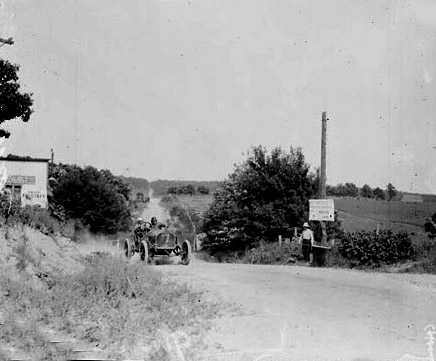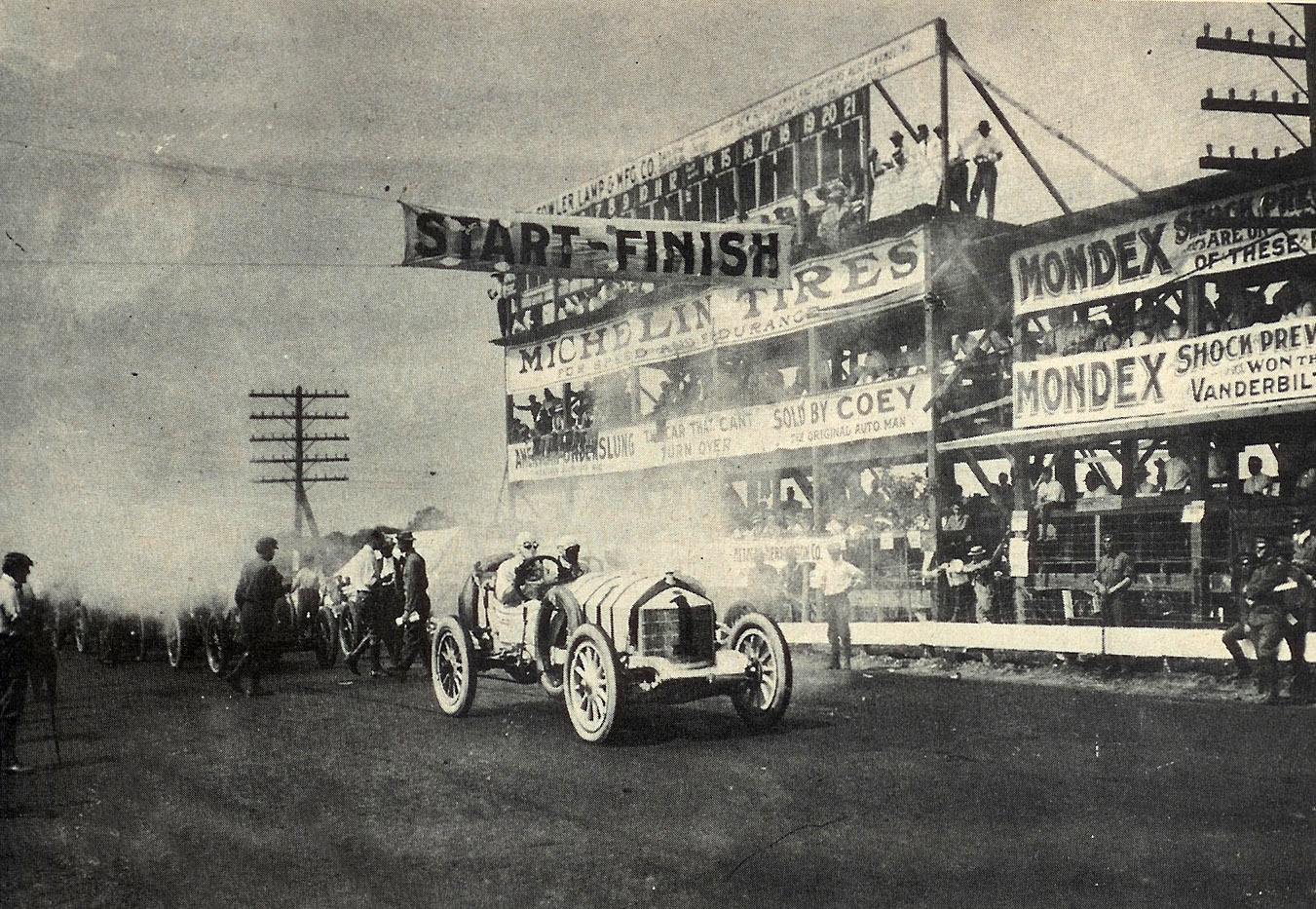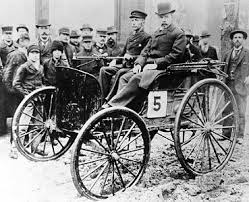

Early Days of Chicago Area Racing—The Turn of the Century and Beyond
by Stan Kalwasinski
Automobile racing in the Chicagoland area dates back to the very first automobile racing contest held in the United States . It was the summer of 1895 and the Chicago Times-Herald newspaper announced that it would be sponsoring the first ever automobile racing event in this country. The gasoline-powered automobile, known to many as the horseless carriage, was new to America with the sight of an automobile on a dirt road pretty much being a rare, attention-grabbing, experience to most citizens.
The event was more of an endurance contest, a test of reliability, more than anything else. The event was open to automobiles with at least three wheels and able to carry at least two persons. Each vehicle would carry the driver and an umpire selected by the event’s judges to make sure that the participates would not be cheating.
The race course route ran some 55 miles from Chicago ’s Jackson Park (near the site of today’s Museum of Science and Industry) to Evanston and back. The event was originally planed for Labor Day and later, November 2, but of the almost 90 potential entries, only a handful were ready to go at that time. The race was rescheduled for Thanksgiving Day, November 28.
A 90-mile exhibition race was held on November 2, pitting Oscar Mueller in a German-made Benz against the Duryea Brothers’ “motocycle.” The Mueller-Benz won handily when a team of horses bolted into the Duryeas’ path in Evanston , forcing the car into a ditch. The car suffered a crumpled differential housing and had to be towed to a railroad station by horse for transport back to the Duryeas’ headquarters in Springfield , Mass.
Race day finally arrived and an early season storm of some 12 inches of snow was on the ground. The snow and frigid temperatures made for slippery road conditions. The roads were dirt and were pretty much designed for horse and buggy/carriage and/or wagon transportation. Only six vehicles arrived that morning with two being electric and powered by batteries and the other four entries powered by gasoline. All the cars were open with no roofs. Three of the gasoline-powered cars were built by German maker Benz with the other gas-powered machine built by American Charles E. Duryea and driven by his brother, J. Frank Duryea.
The icy temperatures combined with the extremely poor road conditions were too much for some of the cars with four of the six “racers” eventually dropping out. Topping a high speed of 7.5 miles per hour, it took the winner, J. Frank Duryea nine hours to grab first place honors. The second and final running contestant rolled in some two hours later.
Duryea’s winnings were $2,000 and worldwide acknowledgment for beating the famous Benz automobile. With the winnings, the Duryea Motor Wagon Company was started and it became the first manufacturer to volume-produce automobiles in 1896.
The old Washington Park horse racing track was the scene of a number of early “racing” events in the area. Washington Park , known as South Park until 1881, was one of Chicago southside's largest and most popular amusement spaces during the early twentieth century. Bounded by 51st and 60th Streets on the north and south, and South Parkway (now Martin Luther King Drive) and Cottage Grove Avenue on the west and east, the park occupied a total of 371 acres and was located approximately six miles south of the central business district (The Loop). The International Automobile Exhibit and Race Meet was held at the track in September of 1900. Some 1,000 fans would attend the event, which saw Alexander Winton capture the 10-mile “free-for-all” race in just over 16 minutes.
The Chicago Automobile Club was the prominent local group that hosted many of the early racing events in the area. In September of 1902, it presented automobile racing at Joliet , which was part of the annual Elks’ carnival. In mid-October, the Harlem race track, located between 12th and 16th streets, just west of Harlem Ave. , was the site of another Chicago Automobile Club-hosted event.
Washington Park hosted several days of racing during Chicago ’s Centennial Celebration on September 29-30, 1903. The Harlem dirt track saw racing again in 1904. Carl Fisher, who later would play a prominent role in the founding of the Indianapolis Motor Speedway, was a “record setter’ during the events which were held September 30 and October 1. Noted American racing driver Barney Oldfield declined to compete after filing an entry and officials of the Chicago Automobile Club insisted that Oldfield be “bared” from further racing competition.
Club officials announced another big racing event for late May in 1905 at Washington Park . The event was eventually moved to the Harlem track with Charles A. Coey in a Thomas being a big winner during the three-day event. Ray Harroun, who would win the inaugural Indianapolis 500 in 1911, would be involved in a test session crash with one Dr. Harold E. Thomas. The Chicago Tribune reported, “Swerving his big sixty horsepower touring car to avoid a collision with a small freak racer driven by R.W. Harroun, Dr. Harold E. Thomas ran into the infield fence at the Harlem track. With a crash that could be heard all over the field, the heavy car plowed through many feet of fence, uprooting eight stout cedar posts. The heavy timbers worked havoc with the machinery, and when the car stopped Dr. Thomas’ legs were pinned against the rear part of the seat. The car did not upset, and its owner escaped with a badly bruised leg, which will necessitate the use of a crutch for several days.”
In 1906, the Hawthorne horse track saw G.V. Rogers capture a 100-mile automobile race during a two-day meet in July. Rogers , piloting a thirty horsepower “runabout” that he designed himself, covered the distance in 2:25:21 on the Fourth of July. Another local horse track, the Libertyville site was the scene of racing action on May 30, 1907 with Coey being among the winners that May 30th day. Later in the summer a 24-hour endurance contest was scheduled for the Harlem dirt oval. Coey in his “Thomas Flyer” would score the victory, totaling up 846 laps on July 12-13, 1907. Another racing event was scheduled for Harlem in late September, but it was weathered out.
1909 saw the Chicago Automobile Club turn its attention to its two-day racing event on the roads of Lowell , Crown Point and Cedar Lake , Indiana . Two days of racing on the 23.27-mile course, made up of mainly rural highways with several long straightaways, one exceeding eight miles, was held on June 18 and June 19, 1909. Joe Matson wheeled his Chalmers-Detroit to victory in the Indiana Trophy race on June 18, covering the 232.7 mile/10 lap distance in 04:31:21 for an average speed of 51.463 miles per hour. 16 cars competed in the event. The following day saw Louis Chevrolet “man handle” his Buick racer in the Cobe Trophy race, covering the 395.6 mile/17 lap distance in 08:01:39 for an average speed of 49.287 miles per hour with 12 cars competing in Saturday’s race. The Cobe Trophy was named in honor of Chicago Automobile Club president, Ira Cobe. The event was a commercial disappointment as spectators chose to watch the races along miles of open countryside, having their own picnics, rather than pay for the grandstands and concessions offered by the promoters.

1909 Cobe Cup Race through Crown Point/Lowell/Cedar Lake
The Hawthorne track, located at 35th Street and Cicero Ave. , was the scene of several events in 1910 and 1911. Sadly, French driver Marcel Basle was fatally injured in a crash at Hawthorne on June 10, 1911. The accident would halt local racing on dirt horse tracks for about two years.
1910 would see the first Elgin National Road Races held. Watching from specially setup grandstands or from some farmer’s field, spectators could watch national racing champions rip around what was a then-rugged 8-mile or so route on the west side of the Fox River and what now is Larkin Avenue, McLean Boulevard, Highland Avenue and Coombs Road, competing for the coveted Elgin National Watch Company Trophy. “Big time” racers of the era like Ralph Mulford, Eddie Hearne, Ralph DePalma, Gil Anderson and Earl Cooper were all winners of various races held on the Elgin course during the pre-World War I years – 1910 through 1915.

Elgin Road Race - 1912
In 1913, the Libertyville horse track would be the scene of the first oval dirt track races held since the Basle fatal accident at Hawthorne in 1911. Promoter J. Alex Sloan would lease that track, calling the Libertyville track the fastest in America . Louis Disbrow dueled with Eddie Rickenbacker in a 10-mile race for 600 or more cubic inch cars with Disbrow claiming the win.
On June 22, 1913, Disbrow drove his Simplex Zip a mile on the Rockford circular dirt track in :54 3-5 in what was described as the first professional auto speed events ever held in the city. Other “front runners” of the era, Claude Newhouse, Henry Ulbrecht (Heinie Ulbricht), Joe Nikrent and “Wild Bill” Endicott were also in competition that day.
The Hawthorne track was the scene of a two-day race meet in early July of 1914. Disbrow, described as the “American circular track champion,” was the “big winner” during the competition, winning a “half-hour race” on the Fourth of July over a challenging Eddie Hearne.
Earlier, in June of 1914, plans were announced for the construction of the mammoth two-mile wooden board track in Maywood — Speedway Park . With a new, high-speed facility built just for auto racing appearing on the scene, local automobile racing would undergo a major change.
END
(Please note…this story will be updated from time to time as additional information is gathered regarding the early history of Chicagoland automobile racing.)
Revised: 01/03/2009

J. Frank Duryea (left) and “umpire” Arthur Rice, at the first auto race.